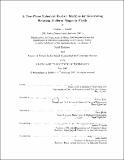| dc.contributor.advisor | Markus Zahn. | en_US |
| dc.contributor.author | Lawler, Clinton T. (Clinton Thomas) | en_US |
| dc.contributor.other | Massachusetts Institute of Technology. Dept. of Electrical Engineering and Computer Science. | en_US |
| dc.date.accessioned | 2008-01-10T14:24:28Z | |
| dc.date.available | 2008-01-10T14:24:28Z | |
| dc.date.copyright | 2007 | en_US |
| dc.date.issued | 2007 | en_US |
| dc.identifier.uri | http://hdl.handle.net/1721.1/39839 | |
| dc.description | Thesis (Nav. E.)--Massachusetts Institute of Technology, Dept. of Mechanical Engineering; and, (S.M.)--Massachusetts Institute of Technology, Dept. of Electrical Engineering and Computer Science, 2007. | en_US |
| dc.description | This electronic version was submitted by the student author. The certified thesis is available in the Institute Archives and Special Collections. | en_US |
| dc.description | Includes bibliographical references (p. 133-138). | en_US |
| dc.description.abstract | This thesis describes the design and construction of a novel two-phase spherical electric machine that generates rotating uniform magnetic fields, known as a fluxball machine. Alternative methods for producing uniform magnetic fields with air-cored solenoidal magnets are discussed and evaluated. Analytical and numerical models of these alternatives are described and compared. The design details of material selection, slot geometry, and mechanical connections are described for the fluxball machine. The electrical properties of the machine are predicted and measured. Based on these properties, two modes of operation for the fluxball machine, normal and resonant, are described, and reference tables of important operating parameters are given. The drive and measurement circuitry for the fluxball machine are described. The magnetic properties of the fluxball machine are measured using Hall effect sensors. The calibration of two different Hall effect sensors is performed, providing the ability to measure the magnetic fields accurately to ±1%. Measurements of the magnetic field in the uniform field region are taken and compared with predicted values. The attenuation and distortion of the magnetic fields due to diffusion through the inner fluxball winding is measured as a function of operating frequency. | en_US |
| dc.description.abstract | (cont.) Finally, future uses of this machine for various applications are discussed. The fluxball machine provides uniform fields in the inner volume and point magnetic dipole fields in the exterior volume. Both regions are extremely useful for conducting controlled magnetic fields experiments. The fact that the machine can produce rotating fields of these types makes it particularly useful for applications in ferrofluid research and in experimental research related to large rotating machinery. | en_US |
| dc.description.statementofresponsibility | by Clinton T. Lawler. | en_US |
| dc.format.extent | 138 p. | en_US |
| dc.language.iso | eng | en_US |
| dc.publisher | Massachusetts Institute of Technology | en_US |
| dc.rights | M.I.T. theses are protected by copyright. They may be viewed from this source for any purpose, but reproduction or distribution in any format is prohibited without written permission. See provided URL for inquiries about permission. | en_US |
| dc.rights.uri | http://dspace.mit.edu/handle/1721.1/7582 | |
| dc.subject | Mechanical Engineering. | en_US |
| dc.subject | Electrical Engineering and Computer Science. | en_US |
| dc.title | A two-phase spherical electric machine for generating rotating uniform magnetic fields | en_US |
| dc.title.alternative | 2-phase spherical electric machine for generating rotating uniform magnetic fields | en_US |
| dc.type | Thesis | en_US |
| dc.description.degree | S.M. | en_US |
| dc.description.degree | Nav.E. | en_US |
| dc.contributor.department | Massachusetts Institute of Technology. Department of Electrical Engineering and Computer Science | |
| dc.contributor.department | Massachusetts Institute of Technology. Department of Mechanical Engineering | |
| dc.identifier.oclc | 182545362 | en_US |
